Microsoft DP-900 Exam Practice Questions (P. 3)
- Full Access (316 questions)
- Six months of Premium Access
- Access to one million comments
- Seamless ChatGPT Integration
- Ability to download PDF files
- Anki Flashcard files for revision
- No Captcha & No AdSense
- Advanced Exam Configuration
Question #21
DRAG DROP -
Match the types of data to the appropriate Azure data services.
To answer, drag the appropriate data type from the column on the left to its service on the right. Each data type may be used once, more than once, or not at all.
NOTE: Each correct match is worth one point.
Select and Place:

Match the types of data to the appropriate Azure data services.
To answer, drag the appropriate data type from the column on the left to its service on the right. Each data type may be used once, more than once, or not at all.
NOTE: Each correct match is worth one point.
Select and Place:

Correct Answer:

Box 1: Image files -
Azure Blob storage is suitable for image files.
Box 2:Key/value pairs -
Azure CosmosDB table API is a key-value storage hosted in the cloud.
Box 3: Relationship between employees
One-to-many relationships between business domain objects occur frequently: for example, one department has many employees. There are several ways to implement one-to-many relationships in the Azure Table service.
Reference:
https://docs.microsoft.com/en-us/azure/storage/tables/table-storage-design-modeling

Box 1: Image files -
Azure Blob storage is suitable for image files.
Box 2:Key/value pairs -
Azure CosmosDB table API is a key-value storage hosted in the cloud.
Box 3: Relationship between employees
One-to-many relationships between business domain objects occur frequently: for example, one department has many employees. There are several ways to implement one-to-many relationships in the Azure Table service.
Reference:
https://docs.microsoft.com/en-us/azure/storage/tables/table-storage-design-modeling
send
light_mode
delete
Question #22
DRAG DROP -
Match the Azure Data Lake Storage Gen2 terms to the appropriate levels in the hierarchy.
To answer, drag the appropriate term from the column on the left to its level on the right. Each term may be used once, more than once, or not at all.
NOTE: Each correct match is worth one point.
Select and Place:
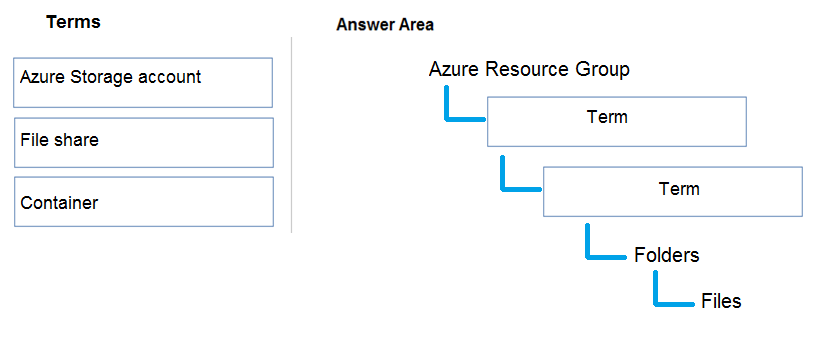
Match the Azure Data Lake Storage Gen2 terms to the appropriate levels in the hierarchy.
To answer, drag the appropriate term from the column on the left to its level on the right. Each term may be used once, more than once, or not at all.
NOTE: Each correct match is worth one point.
Select and Place:

Correct Answer:
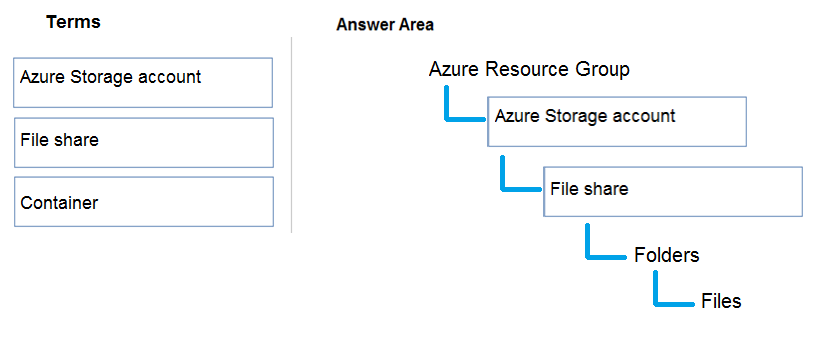
Box 1: Azure Storage account -
Azure file shares are deployed into storage accounts, which are top-level objects that represent a shared pool of storage.
Box 2: File share -
Reference:
https://docs.microsoft.com/en-us/azure/storage/files/storage-how-to-create-file-share

Box 1: Azure Storage account -
Azure file shares are deployed into storage accounts, which are top-level objects that represent a shared pool of storage.
Box 2: File share -
Reference:
https://docs.microsoft.com/en-us/azure/storage/files/storage-how-to-create-file-share
send
light_mode
delete
Question #23
What are two characteristics of real-time data processing? Each correct answer presents a complete solution.
NOTE: Each correct selection is worth one point.
NOTE: Each correct selection is worth one point.
- AData is processed periodically
- BLow latency is expectedMost Voted
- CHigh latency is acceptable
- DData is processed as it is createdMost Voted
Correct Answer:
BD
Real time processing deals with streams of data that are captured in real-time and processed with minimal latency to generate real-time (or near-real-time) reports or automated responses.
Reference:
https://docs.microsoft.com/en-us/azure/architecture/data-guide/big-data/real-time-processing
BD
Real time processing deals with streams of data that are captured in real-time and processed with minimal latency to generate real-time (or near-real-time) reports or automated responses.
Reference:
https://docs.microsoft.com/en-us/azure/architecture/data-guide/big-data/real-time-processing
send
light_mode
delete
Question #24
DRAG DROP -
Match the Azure Data Factory components to the appropriate descriptions.
To answer, drag the appropriate component from the column on the left to its description on the right. Each component may be used once, more than once, or not at all.
NOTE: Each correct match is worth one point.
Select and Place:

Match the Azure Data Factory components to the appropriate descriptions.
To answer, drag the appropriate component from the column on the left to its description on the right. Each component may be used once, more than once, or not at all.
NOTE: Each correct match is worth one point.
Select and Place:

Correct Answer:

Box 1: Dataset -
Datasets must be created from paths in Azure datastores or public web URLs, for the data to be accessible by Azure Machine Learning.
Box 2: Linked service -
Linked services are much like connection strings, which define the connection information needed for Data Factory to connect to external resources.
Box 3: Pipeline -
A pipeline is a logical grouping of activities that together perform a task.
Reference:
https://k21academy.com/microsoft-azure/dp-100/datastores-and-datasets-in-azure/ https://docs.microsoft.com/en-us/azure/data-factory/concepts-linked-services https://docs.microsoft.com/en-us/azure/data-factory/concepts-pipelines-activities

Box 1: Dataset -
Datasets must be created from paths in Azure datastores or public web URLs, for the data to be accessible by Azure Machine Learning.
Box 2: Linked service -
Linked services are much like connection strings, which define the connection information needed for Data Factory to connect to external resources.
Box 3: Pipeline -
A pipeline is a logical grouping of activities that together perform a task.
Reference:
https://k21academy.com/microsoft-azure/dp-100/datastores-and-datasets-in-azure/ https://docs.microsoft.com/en-us/azure/data-factory/concepts-linked-services https://docs.microsoft.com/en-us/azure/data-factory/concepts-pipelines-activities
send
light_mode
delete
Question #25
DRAG DROP -
Match the types of workloads to the appropriate scenarios.
To answer, drag the appropriate workload type from the column on the left to its scenario on the right. Each workload type may be used once, more than once, or not at all.
NOTE: Each correct match is worth one point.
Select and Place:

Match the types of workloads to the appropriate scenarios.
To answer, drag the appropriate workload type from the column on the left to its scenario on the right. Each workload type may be used once, more than once, or not at all.
NOTE: Each correct match is worth one point.
Select and Place:

Correct Answer:

Box 1: Batch -
Batch processing refers to the processing of blocks of data that have already been stored over a period of time.
Box 2: Streaming -
Stream processing is a big data technology that allows us to process data in real-time as they arrive and detect conditions within a small period of time from the point of receiving the data. It allows us to feed data into analytics tools as soon as they get generated and get instant analytics results.
Box 3: Batch -
Reference:
https://docs.microsoft.com/en-us/azure/architecture/data-guide/technology-choices/batch-processing

Box 1: Batch -
Batch processing refers to the processing of blocks of data that have already been stored over a period of time.
Box 2: Streaming -
Stream processing is a big data technology that allows us to process data in real-time as they arrive and detect conditions within a small period of time from the point of receiving the data. It allows us to feed data into analytics tools as soon as they get generated and get instant analytics results.
Box 3: Batch -
Reference:
https://docs.microsoft.com/en-us/azure/architecture/data-guide/technology-choices/batch-processing
send
light_mode
delete
Question #26
DRAG DROP -
Your company plans to load data from a customer relationship management (CRM) system to a data warehouse by using an extract, load, and transform (ELT) process.
Where does data processing occur for each stage of the ELT process? To answer, drag the appropriate locations to the correct stages. Each location may be used once, more than once, or not at all. You may need to drag the split bar between panes or scroll to view content.
NOTE: Each correct selection is worth one point.
Select and Place:

Your company plans to load data from a customer relationship management (CRM) system to a data warehouse by using an extract, load, and transform (ELT) process.
Where does data processing occur for each stage of the ELT process? To answer, drag the appropriate locations to the correct stages. Each location may be used once, more than once, or not at all. You may need to drag the split bar between panes or scroll to view content.
NOTE: Each correct selection is worth one point.
Select and Place:

Correct Answer:

Box 1: The CRM system -
Data is extracted from the CRM system.
Box 2: The data warehouse -
Data is loaded to the data warehouse.
Box 3: A standalone data analysis tool
The data transformation that takes place usually involves various operations, such as filtering, sorting, aggregating, joining data, cleaning data, deduplicating, and validating data.
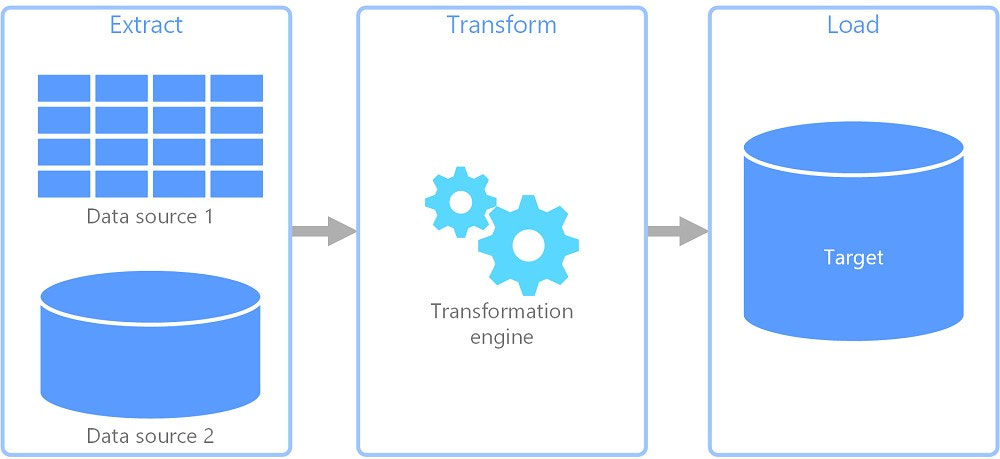
Reference:
https://docs.microsoft.com/en-us/azure/architecture/data-guide/relational-data/etl

Box 1: The CRM system -
Data is extracted from the CRM system.
Box 2: The data warehouse -
Data is loaded to the data warehouse.
Box 3: A standalone data analysis tool
The data transformation that takes place usually involves various operations, such as filtering, sorting, aggregating, joining data, cleaning data, deduplicating, and validating data.

Reference:
https://docs.microsoft.com/en-us/azure/architecture/data-guide/relational-data/etl
send
light_mode
delete
Question #27
Your company recently reported sales from the third quarter.
You have the chart shown in the following exhibit.
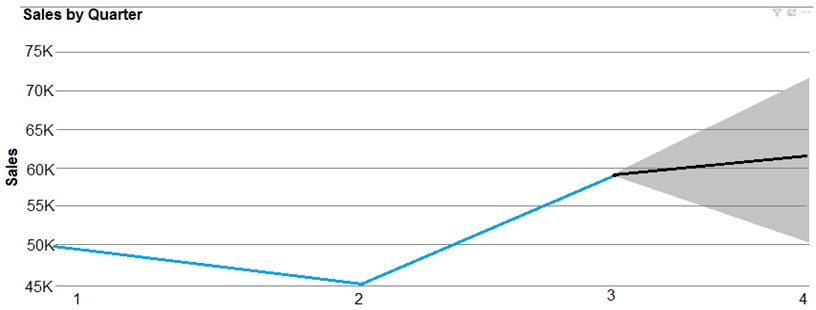
Which type of analysis is shown in the fourth quarter?
You have the chart shown in the following exhibit.

Which type of analysis is shown in the fourth quarter?
- ApredictiveMost Voted
- Bprescriptive
- Cdescriptive
- Ddiagnostic
Correct Answer:
A
Predictive, to answer the question: What will happen?
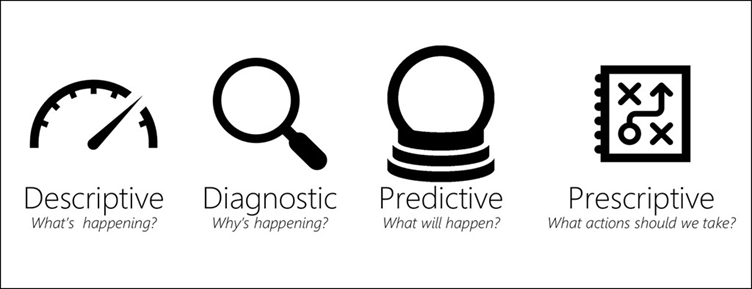
Reference:
https://demand-planning.com/2020/01/20/the-differences-between-descriptive-diagnostic-predictive-cognitive-analytics/ https://azure.microsoft.com/en-us/blog/answering-whats-happening-whys-happening-and-what-will-happen-with-iot-analytics/
A
Predictive, to answer the question: What will happen?

Reference:
https://demand-planning.com/2020/01/20/the-differences-between-descriptive-diagnostic-predictive-cognitive-analytics/ https://azure.microsoft.com/en-us/blog/answering-whats-happening-whys-happening-and-what-will-happen-with-iot-analytics/
send
light_mode
delete
Question #28
Which statement is an example of Data Manipulation Language (DML)?
- AREVOKE
- BDISABLE
- CCREATE
- DUPDATEMost Voted
Correct Answer:
D
Data Manipulation Language (DML) affect the information stored in the database. Use these statements to insert, update, and change the rows in the database.
BULK INSERT -
DELETE -
INSERT -
SELECT -
UPDATE -
MERGE -
Reference:
https://docs.microsoft.com/en-us/sql/t-sql/statements/statements
D
Data Manipulation Language (DML) affect the information stored in the database. Use these statements to insert, update, and change the rows in the database.
BULK INSERT -
DELETE -
INSERT -
SELECT -
UPDATE -
MERGE -
Reference:
https://docs.microsoft.com/en-us/sql/t-sql/statements/statements
send
light_mode
delete
Question #29
HOTSPOT -
To complete the sentence, select the appropriate option in the answer area.
Hot Area:

To complete the sentence, select the appropriate option in the answer area.
Hot Area:

Correct Answer:

Descriptive, to answer the question: What's happening?
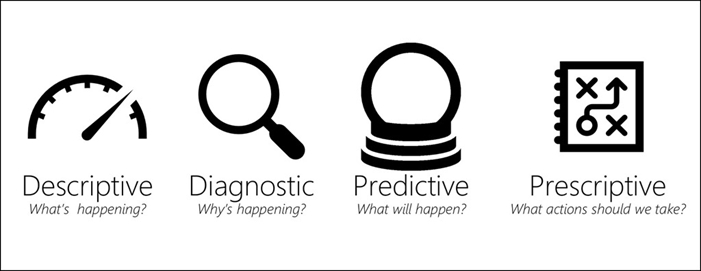
Note: Azure Media Indexer enables you to make content of your media files searchable and to generate a full-text transcript for closed captioning and keywords.
You can process one media file or multiple media files in a batch.
Reference:
https://demand-planning.com/2020/01/20/the-differences-between-descriptive-diagnostic-predictive-cognitive-analytics/ https://azure.microsoft.com/en-us/blog/answering-whats-happening-whys-happening-and-what-will-happen-with-iot-analytics/ https://docs.microsoft.com/en-us/azure/media-services/previous/media-services-index-content

Descriptive, to answer the question: What's happening?

Note: Azure Media Indexer enables you to make content of your media files searchable and to generate a full-text transcript for closed captioning and keywords.
You can process one media file or multiple media files in a batch.
Reference:
https://demand-planning.com/2020/01/20/the-differences-between-descriptive-diagnostic-predictive-cognitive-analytics/ https://azure.microsoft.com/en-us/blog/answering-whats-happening-whys-happening-and-what-will-happen-with-iot-analytics/ https://docs.microsoft.com/en-us/azure/media-services/previous/media-services-index-content
send
light_mode
delete
Question #30
HOTSPOT -
To complete the sentence, select the appropriate option in the answer area.
Hot Area:
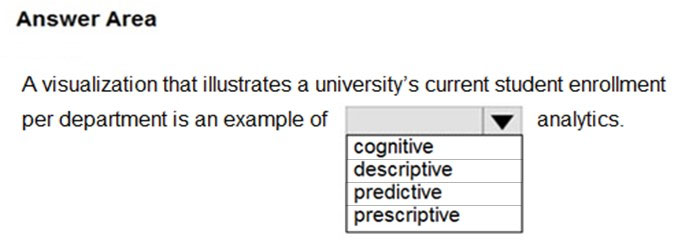
To complete the sentence, select the appropriate option in the answer area.
Hot Area:

Correct Answer:
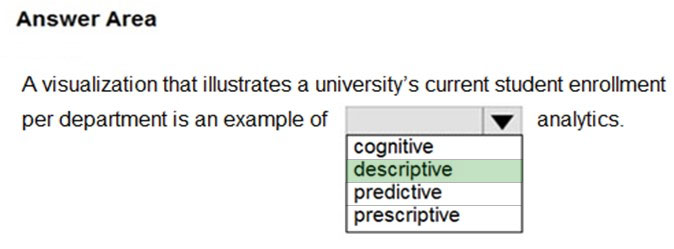
Generally speaking, data analytics comes in four types:
1. Descriptive, to answer the question: What's happening?
2. Diagnostic, to answer the question: Why's happening?
3. Predictive, to answer the question: What will happen?
4. Prescriptive, to answer the question: What actions should we take?
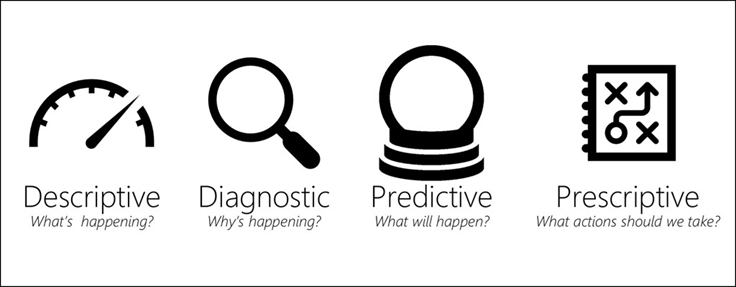
Reference:
https://azure.microsoft.com/en-us/blog/answering-whats-happening-whys-happening-and-what-will-happen-with-iot-analytics/

Generally speaking, data analytics comes in four types:
1. Descriptive, to answer the question: What's happening?
2. Diagnostic, to answer the question: Why's happening?
3. Predictive, to answer the question: What will happen?
4. Prescriptive, to answer the question: What actions should we take?

Reference:
https://azure.microsoft.com/en-us/blog/answering-whats-happening-whys-happening-and-what-will-happen-with-iot-analytics/
send
light_mode
delete
All Pages
